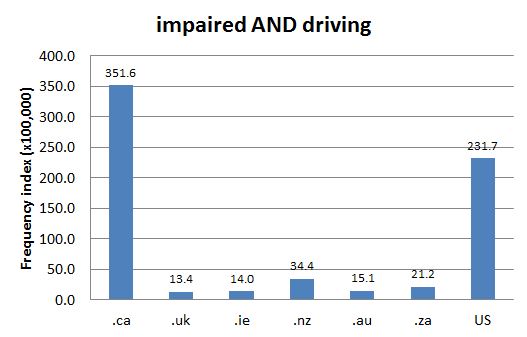DCHP-2
impaired DCHP-2 (April 2016)
adj. — Law
under the influence of an intoxicant, usually alcohol.
Type: 5. Frequency — While impaired generally means "rendered worse; injured in amount, quality, or value; deteriorated, weakened, damaged" (see OED-3, s.v. "impaired" (1)), the term has undergone semantic change in North America to denote the state of being under the influence of alcohol or drugs when driving. The meaning is a shortening of phrases such as "driving ability is impaired" (see the 1950 quotation). In Canada, the phrase "impaired driving" is understood to mean driving while the ability to do so is impaired by drugs or alcohol, not vision impairments etc., and this usage is most frequent in Canada (see Chart 1).
In 1921, Parliament introduced the offence of "driving while intoxicated" - and this was understood to mean "substantial inebriation". But by the 1950s, research had shown that by the time people showed these outward signs of inebriation, their blood alcohol levels were already too high. Consequently, in 1951 the Criminal Code was amended to change the offence from driving while intoxicated to driving while the driver's ability to do so was "impaired" by drugs or alcohol (Kenkel 2009: 1-2). Section 253 of the Criminal Code of Canada states that "Every one commits an offence who operates a motor vehicle [...] (a) while the person's ability to operate the vehicle, vessel, aircraft or railway equipment is impaired by alcohol or a drug" (see Justice Laws reference).
See also COD-2, s.v. "impaired" (1), which is marked "Cdn", Gage-5, s.v. "impaired", which is marked "Cdn. Law", and OED-3, s.v. "impaired" (2), which is marked "Canad.".References:
- COD-2
- Gage-5
- ITP Nelson
- Justice Laws Canada Criminal Code Accessed 15 Aug. 2013
- Kenkel (2009)
- OED-3
Images:
Chart 1: Internet Domain Search, 14 Aug. 2012
